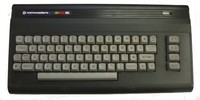Commodore 16
| Home > Browse Our Collection > Computers > Commodore > Commodore 16 |
|
The Commodore 16 was a home computer made by Commodore, released in 1984. It was intended to be an entry-level computer to replace the VIC-20.
The C16 was one of three computers in the 264 family.
The original design for the computer, was born from a meeting sometime in late 1982, where one of the designers, Bil Herd was given a Timex computer from a filing cabinet (also made by Commodore), and told to come up with something for $49. The machine produced was the Commodore 116 (pictured), with its TED chip (Text Editing Device), which contained all the functions of the computer from the graphics and sound, right down to the joystick ports, the computer was slightly larger than a ZX Spectrum, with a similar, but even more awkward rubber keyboard, the machine had no sprite capabilities, being built entirely as a cheap business machine, its case was similar to the later Commodore Plus 4. More machines were added to the range, the Commodore 232, 264 and V364, none of which made it to market.
Commodore and in particular Jack Tramiel, did not want to be left out of the potential budget computer market, and the competition therein from Timex and Texas Instruments, and he was also convinced the Japanese were about to flood the market with cheap micros, in reality Timex and Texas soon left the computer scene, and the Japanese invasion did not happen. This left the 264 machine with no market, in mid 1984, the 50,000 manufactured C116 machines were sent to Europe, mainly Germany, where it was not a great success, mainly due to the price being raised to over one hundred dollars more than intended, and no more were produced, the machine is now a rare collector's item, and quite hard to find in a working condition. After Jack Tramiel was ousted from the company, Commodore sat on the chipset for a good while, before deciding that an opportunity was there for the aged VIC-20 to be replaced, so the Commodore 16 was conceived, Bil Herd was later to describe the machine as an abomination, and inbred, it shipped in an identical case to the C64 and VIC-20, but was charcoal black with grey keys.
Performance-wise located between the VIC and C64, it had an 8501 CPU, similar to the 6502 processor, (which actually ran 3 times faster than that in the C64, but with no extra hardware to back it up) 16 KB of RAM with 12 KB available to its built-in BASIC interpreter, and a new sound and video chipset offering a palette of 128 colours, far more than the C64. The ROM resident BASIC 3.5, however, was more powerful than the VIC-20's and C64's BASIC 2.0, in that it had commands for sound and bitmapped graphics (320×200 pixels), as well as simple program tracing/debugging. Looking physically similar to the Vic 20 and Commodore 64, the tiny board of the C116 was expanded to fit the expansion slots in the case, There is a cart socket on the rear, though this is quite different to the other machines, and the cartridges were not compatible, it was also where RAM packs could be inserted to give the machine much needed extra memory, but perhaps the most use of the port was the C16/Plus4 exclusive 1551 Disk Drive, this had a parallel interface that was much faster than the standard serial Disk Drives such as the 1541 or 1570. The machine could also use these other drives through the serial port also on the back. Next to the serial was the video out, and the RF out is also on the rear, also the cassette interface is on the back which used the machine's 1531 tape drive. The right hand side of the machine has the two DIN joystick plugs, the 9V power socker and the on/off switch. The processor was similar to the 6502 the Vic and C64 machines used, so converting software would be relatively easy, but few companies bothered, as the performance of the machines at retail, meant it was not economical.
The machine did especially well in the UK, having a very good year in 1985, when Commodore UK did a great job of putting an entry level package together, with a fair mix of educational software, and games aimed at younger players. The price was slashed from its £149 starting price to £89, and finally to the invisaged price point of the C116 of £49.
There is still a vibrant homebrew scene for the machines, and with the C116 and C16 being relatively easy to modify up to 64K, some very nice software titles are still being produced that can be played on all three machines in the series.
Manufacturer: Commodore Comment on This Page Commodore 16 Manuals:
Other Systems Related To Commodore 16:This exhibit has a reference ID of CH227. Please quote this reference ID in any communication with the Centre for Computing History. |
Click on the Image(s) For Detail
|


























